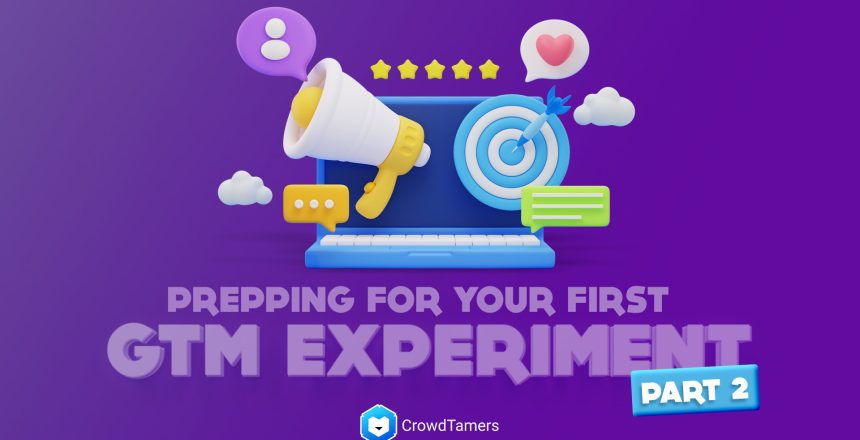Dear Founder, here’s a quick recap from our previous conversation, where we spoke about running your first go-to-market experiment:
One – Research is essential to running a successful first go-to-market experiment.
Two – Your research should cover three main parts: The market, the potential audience, and your competitors.
With all this in place, you’re ready to set up your first go-to-market experiment.
If not, go back to step 1: Prepping for your first GTM experiment – Research.
Now moving on to prepping your messaging and design.
Your messaging and design come together to form those catchy visuals you see on Facebook ads, LinkedIn, or whatever platform you’re on. Getting messaging and design right is crucial because it is one of the first interactions your audience will have with your brand. Done correctly, it’s vital to attracting and retaining your customers, so it’s essential to ensure you get it right. So how do you move from research to messaging and then design? Here’s how.
Let’s go from research to message
By now, based on your research, you have some understanding of the following:
- how your industry works,
- what pain points your audience faces and are looking to solve and
- What your competitors are currently doing?
This information is critical when you’re preparing your messaging.
Crafting the message for your go-to-market experiment.
On the CrowdTamers blog, we’ve spoken about our approach to tackling messaging. From showing you how to craft high-performance headlines to positioning tricks to nail your go-to-market copywriting, we’re constantly exploring ways you can make the most of your writing.
Because this is your first go-to-market experiment, you want to keep this in mind when writing- your message should speak to your users’ pain points rather than the features of your product/service.
Sell the benefits of your product rather than the features. Fight the urge to write ‘The best back scratcher you’ve ever used‘ and instead, go with ‘Get instant relief from that niggling, unreachable itch.’ When your writing is benefit-focused, it shows the natural place that your product has in your audience’s life.
Write using the appeals.
At CrowdTamers, we often speak about the three appeals we use in our approach to writing:
- The logical appeal speaks to how the product or service saves money and time or how it changes how you live/work/interact. This usually looks like ‘See how XYZ can save you $$$‘ or ‘Quit wasting valuable hours. Try XYZ‘.
- The emotional appeal – Here, we address the messaging from the negative and positive emotions. Based on your research, this is where you speak to the pain point of your target audience. It’ll look like this: ‘Frustrated at your low conversion rates? Boost it with XYZ’.
- You can also explore the feeling of belonging – to a community or tribe. It makes them feel less like a lone user and more like they are part of something bigger.
- Social proof. – Seeing that this is your first experiment, you may have limited testimonials or social proof. You can get quotes from famous people that validate your idea, get a friend to say something on social media that you can use, or tell a story your audience can connect to. Never fear.
To delve deeper into these appeals, here’s a blog post that can help. There are other approaches to crafting high-performing headlines for your growth experiments, but these are the three we use the most.
Now that your messaging is ready, you can pass it on to design.
Moving on to design.
The first thing when you get copy is to do some more research. In this case, you want to see what the trends are for the industry you’re in. Scope out your competitors within the industry, find out what your competitors are doing, which of their designs are performing well, and how these trends work with your brand guidelines. It’s important to know what will resonate with your target audience. Based on the research carried out in part 1, clearly articulated in your ad copy, you want to ensure that your designs communicate the value this service delivers to the target audience.
Beyond industry trends and brand guidelines, two key considerations when choosing a design style:
- who the target audience is and
- the best way to bring the message to life.
It will guide your choice when picking a design style for your first go-to-market experiment.
You want to get attention in a way that delivers the message as easily and quickly as possible. In our experience, designs with clear imagery, and fonts, have proven to be more effective than complex designs. You can explore static images or videos, but the platform on which you’re running these ads can also determine the format.
You want to keep the research deck from part 1 close when creating your design. You’ll get industry-relevant insights and information that can help you design for your audience.
What design tools do we recommend?
There are many design tools for creating compelling visuals. From Adobe creative suite to Figma and even Canva, you’ll need a design tool that lets you make a wide variety of ad formats, including images, graphics, and videos. There’s no hard and fast rule – anything that gets the job done without delay will do. Ultimately the design tool you use will depend on your specific needs and the format of your designs.
Now your designs are ready and set to go. We’re ready to move on to part 3 – running your first go-to-market experiment.



